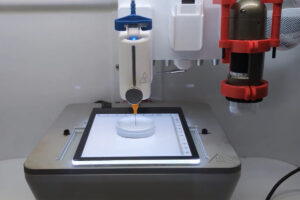New 3D bioprinting technique improves tissue production

Modular and AI-driven in situ monitoring platform for real-time process analysis (Credit: MIT)
September 17, 2025 – 3D bioprinting, which uses living cells, biocompatible materials, and growth factors to build three-dimensional tissues and organ structures, has become an important tool in biomedical science. Until now, one of the most common methods has relied on additive manufacturing and digital models: layers of bio-ink – cells embedded in a soft gel – are deposited step by step in a support bath to create a 3D structure.
While this approach enables the fabrication of complex architectures that cannot easily be built by hand, it also has limitations. The process is difficult to fully control, which can lead to defects in printed tissue. Improved process monitoring would already represent a significant step forward.
Researchers at the Massachusetts Institute of Technology (MIT) have now developed a modular, low-cost, and printer-independent monitoring technique that can quickly detect printing defects, such as applying too much or too little bio-ink. This allows them to optimize printing parameters for a wide range of materials.
According to the team, the system is more than just a monitoring tool. It can serve as the foundation for intelligent process control in embedded bioprinting. By enabling real-time inspection, automated correction, and adaptive parameter tuning, the researchers expect the technique to improve reproducibility, reduce material waste, and accelerate the practical application of bioprinting in tissue engineering.









